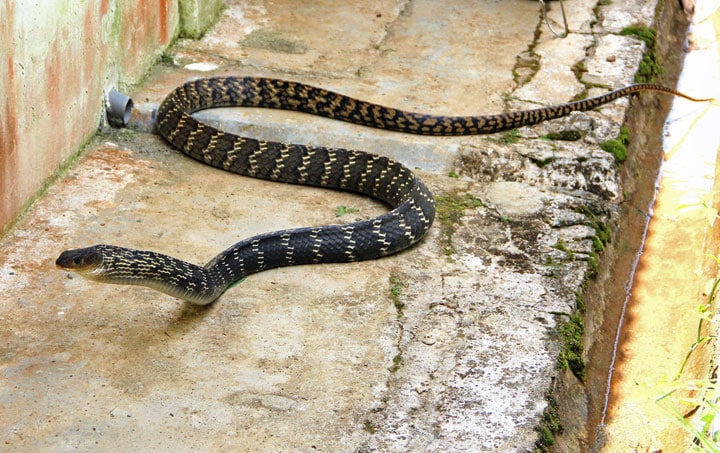Snakes in Thailand: Keel Rat Snake (Ptyas carinata)

The keeled rat snake (Ptyas carinata) belongs to the Colubridae family. The snake is found in Indonesia, Myanmar, Malaysia, Thailand, Philippines, Cambodia, Vietnam and Singapore.
The Keel Rat Snake (Ptyas carinata) is a species of non-venomous snake found in Southeast Asia. These snakes can be found in a wide variety of habitats ranging from forests and grasslands to agricultural areas and villages. They are known for their quick movements and agility and are excellent climbers.
Keel rat snakes can reach a length of about 3 meters, although most specimens are smaller. They have a slender body and a long, thin tail. The scales on their backs are keeled, meaning they have a raised rim in the middle. This texture of the scales is where the name "Keel Rat Snake" comes from. Their color varies from brown to olive green, with paler flanks and a white or yellowish underside.
Ptyas carinata is a nocturnal snake that usually hides in burrows or under vegetation during the day. They are mainly terrestrial, but can also swim well and climb trees in search of food. Their diet consists mainly of rodents, such as rats and mice, but they also eat other small animals such as lizards, frogs and birds.
Keel rat snakes are oviparous, usually laying between 10 and 20 eggs per clutch. The eggs are usually laid in burrows or under vegetation and hatch after about two to three months.
Although the Keel Rat Snake is not venomous, they can bite if they feel threatened. However, they are generally not aggressive and will try to escape rather than attack. Because of their rodent diet, these snakes can be useful in rural and agricultural areas by helping to control rodent populations.

Special features and characteristics of the Keel Rat Snake (Ptyas carinata)
- Name in English: Keeled rat snake
- Name in Thai: งู สิง หางดำ, ngu zing hang damm
- Scientific name: Ptyas carinata, Albert Charles Lewis Gunther, 1858
- Is found in: Indonesia, Myanmar, Malaysia, Thailand, Philippines, Cambodia, Vietnam and Singapore.
- Eating pattern: Rodents and lizards.


Extra information:
Defensive Behavior: These snakes are quite adept at defending themselves. They have almost endless energy and don't seem to stop after 10-20 attacks like most snakes, they can go over 60 times.
Venom Toxicity: These are rat snakes, they have venom in their saliva, but it doesn't work on humans to cause severe poisoning. These are aglyphs – without tusks. Ptyas carinatus venom is rich in neurotoxic 3FTx and affects animals that eat them, but not humans.
Toxic to humans? In which area is it mainly found?
No, non-toxic. There are not that many venomous snakes in Thailand. If you leave a snake alone nothing will happen to you. Most bites result from trying to remove snakes. Never do it yourself if you don't understand it.
This snake is one of the protected snakes in Thailand, like all other rat snakes.
Dangerous/Harmless
Dear Snake connoisseurs/enthusiasts
I find snakes very interesting animals and always watch them from a healthy distance, but will never want to harm them if the situation allows.
That is why I follow this series with interest, but what often strikes me is that the conclusion dangerous or harmless to humans is only explained as the final piece or is even underexposed, and in my opinion that is what most readers really want to know ……
What I also think is that because there are so many species, most Thai residents approach all snakes like a cobra and want to smack them flat because they can't or don't want to see a difference. According to various sources, about 8% of the snakes present in Thailand are dangerous to humans, it might be better if only these snakes were first brought to the attention of the Thai and the Farang so that we can see the forest again through all snakes .
Yours faithfully,
Rick (Cha Am)